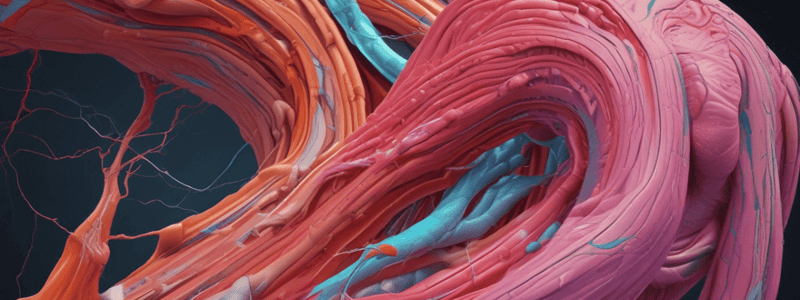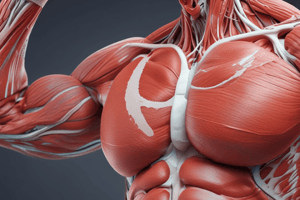Podcast
Questions and Answers
Which type of muscle tissue has the ability to contract and shorten?
Which type of muscle tissue has the ability to contract and shorten?
- Skeletal muscle (correct)
- Cardiac muscle
- Smooth muscle
- All of the above
Which type of muscle tissue is found in the heart?
Which type of muscle tissue is found in the heart?
- Smooth muscle
- Cardiac muscle (correct)
- Both cardiac and smooth muscle
- Skeletal muscle
Which property of muscle tissue allows it to return to its original shape after being stretched?
Which property of muscle tissue allows it to return to its original shape after being stretched?
- Elasticity (correct)
- Contractility
- Extensibility
- Excitability
Which skeletal muscle function is responsible for maintaining body posture?
Which skeletal muscle function is responsible for maintaining body posture?
What is the basic structural unit of skeletal muscle?
What is the basic structural unit of skeletal muscle?
Which type of muscle tissue is found in the walls of blood vessels and the digestive tract?
Which type of muscle tissue is found in the walls of blood vessels and the digestive tract?
What is the primary function of the epimysium?
What is the primary function of the epimysium?
Which of the following is NOT a unique structure found in muscle fibers?
Which of the following is NOT a unique structure found in muscle fibers?
What is the function of myoglobin in muscle fibers?
What is the function of myoglobin in muscle fibers?
Which connective tissue layer separates individual muscles?
Which connective tissue layer separates individual muscles?
What is the primary function of the thick filaments (myosin) in skeletal muscle?
What is the primary function of the thick filaments (myosin) in skeletal muscle?
What is the function of the sarcoplasmic reticulum in muscle fibers?
What is the function of the sarcoplasmic reticulum in muscle fibers?
Which of the following structures makes up the contractile unit of a myofibril?
Which of the following structures makes up the contractile unit of a myofibril?
What is the role of the regulatory proteins (troponin and tropomyosin) in the thin filaments?
What is the role of the regulatory proteins (troponin and tropomyosin) in the thin filaments?
What is the purpose of the $M$-line in the organization of the thick and thin filaments?
What is the purpose of the $M$-line in the organization of the thick and thin filaments?
What is the significance of the $H$-zone in the sarcomere?
What is the significance of the $H$-zone in the sarcomere?
What is the relationship between the motor neuron and the muscle fibers it innervates?
What is the relationship between the motor neuron and the muscle fibers it innervates?
What is the significance of the all-or-none response of a motor unit?
What is the significance of the all-or-none response of a motor unit?
What is the primary reason for increased muscle strength after eccentric contractions?
What is the primary reason for increased muscle strength after eccentric contractions?
In isometric contractions, what is the relationship between the force of contraction and the force of the load?
In isometric contractions, what is the relationship between the force of contraction and the force of the load?
Which factor is primarily responsible for determining the amount of muscle tension produced during exercise?
Which factor is primarily responsible for determining the amount of muscle tension produced during exercise?
Which of the following statements about cardiac muscle is incorrect?
Which of the following statements about cardiac muscle is incorrect?
Which type of smooth muscle is characterized by individual fibers, each with its own motor neuron terminal?
Which type of smooth muscle is characterized by individual fibers, each with its own motor neuron terminal?
What is the approximate muscle mass loss between the ages of 30 and 80?
What is the approximate muscle mass loss between the ages of 30 and 80?
Which of the following correctly describes the order in which energy sources are used during muscle contraction?
Which of the following correctly describes the order in which energy sources are used during muscle contraction?
Which of the following statements about slow-twitch (Type I) muscle fibers is NOT true?
Which of the following statements about slow-twitch (Type I) muscle fibers is NOT true?
Which of the following is true about the "wash theory" in relation to muscle fiber types?
Which of the following is true about the "wash theory" in relation to muscle fiber types?
What is the primary energy system used by fast-twitch (Type IIb) muscle fibers?
What is the primary energy system used by fast-twitch (Type IIb) muscle fibers?
Which of the following statements about the distribution of muscle fiber types is true?
Which of the following statements about the distribution of muscle fiber types is true?
What is the difference between concentric and eccentric muscle contractions?
What is the difference between concentric and eccentric muscle contractions?
Flashcards are hidden until you start studying



